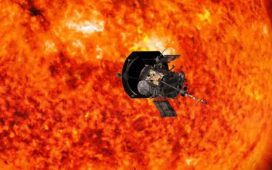The vast subterranean ocean of Europa, one of Jupiter’s many moons, contains carbon, one of the crucial ingredients for life, scientists have discovered.
The observations, by the James Webb space telescope, indicate that carbon dioxide ice on the moon’s surface originated from the salty ocean that lies beneath a 10-mile thick crust of ice. Although the findings do not answer the question of whether alien life is lurking in the cold, gloomy depths, they add weight to the view that Europa’s ocean could be the most promising place in the solar system to go looking for it.
“This is a big deal and I am very excited by it,” said Dr Christopher Glein, a geochemist at Southwest Research Institute, in Texas, US, and co-author. “We don’t know yet if life is actually present in Europa’s ocean. But this new finding adds evidence to the case that Europa’s ocean would be a good bet for hosting extant life. That environment looks tantalising from the perspective of astrobiology.”
At 2,000 miles wide, Europa is slightly smaller than Earth’s moon. Hypothetical lifeforms would have to contend with some extreme adversities, including surface temperatures than rarely exceed -140C and incoming radiation from Jupiter. But, Europa’s ocean – 40-100 miles (64-160km) deep, 10 to 15 miles beneath its icy surface – has made the moon a leading contender in the search for life. The deep ocean’s potential habitability depends on its chemistry, including the abundance of biologically essential elements such as carbon.
Previous research has identified the presence of solid CO2 ice on Europa’s surface, but it was not clear whether this had been spewed up by the subsurface ocean or was delivered to the moon’s surface by meteorite impacts. The latest observations used near-infrared observations by the James Webb telescope to map the distribution of CO2 on Europa’s surface. This showed a hotspot of CO2 in Tara Regio, a roughly 695 sq mile (1,800 sq km) region of so-called “chaos terrain”. Here the surface is dominated by glacial cracks and icy ridges, formed as blocks of ice have been forced to the surface through geological processes.
“The discovery of carbon dioxide in salt-rich regions of Europa’s ice shell indicates that the CO2 is coming from the ocean below and not from outside sources, such as meteorites and ions bombarding Europa,” said Kevin Hand, an astrobiologist at Nasa’s Jet Propulsion Laboratory and co-author.
Hand described the finding as “critical”. “Life as we know it loves to eat and breathe carbon dioxide and thus the indication that Europa’s ocean may have an abundance of CO2 bodes very well for the habitability, and any potential inhabitants, of that ocean.”
Astrobiologists often refer to the “big six” elements that occur in life on Earth: carbon, hydrogen, oxygen, nitrogen, phosphorus and sulphur. Four of these – carbon, hydrogen, oxygen and sulphur – have now been identified on Europa, although it is not yet clear whether sulphur arrived at the surface from the ocean or came from another of Jupiter’s moons, Io.
“The availability of carbon in Europa’s ocean supports the habitability of Europa’s ocean,” said Glein. “Future observations by JWST and the Europa Clipper mission, set to launch next year, should provide us with further clues on whether other building blocks of life, such as nitrogen, are readily available on Europa.”
The findings were published in the journal Science alongside a second analysis that also analysed the ratio of carbon isotopes (different forms of the element) on Europa. A high carbon-12 to carbon-13 ratio can be an indicator of living processes, but the analysis proved inconclusive in this case.
Prof Andrew Coates, head of planetary science at University College London’s Mullard Space Science Laboratory, who was not involved in the work, said the findings were “important and interesting”. “For life, you need liquid water, the right chemistry, a source of energy and enough time for life to develop,” he added. “We think all of those may be present on Europa.”












